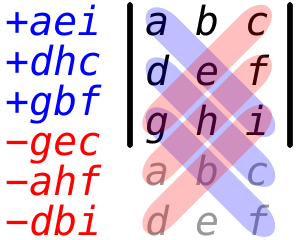Determinant facts for kids
The determinant of a square matrix is a scalar (a number) that indicates how that matrix behaves. It can be calculated from the numbers in the matrix.
The determinant of the matrix  is written as
is written as  or
or  in a formula. Sometimes, instead of
in a formula. Sometimes, instead of  and
and  , one simply writes
, one simply writes  and
and  .
.
Contents
Singular matrices
A matrix has an inverse matrix exactly when the determinant is not 0. For this reason, a matrix with a non-zero determinant is called invertible. If the determinant is 0, then the matrix is called non-invertible or singular.
Geometrically, one can think of a singular matrix as "flattening" the parallelepiped into a parallelogram, or a parallelogram into a line. Then the volume or area is 0, which means that there is no linear map that will bring the old shape back.
Calculating a determinant
There are a few ways to calculate a determinant.
Formulas for small matrices
- For
 and
and  matrices, the following simple formulas hold:
matrices, the following simple formulas hold:

- For
 matrices, the formula is:
matrices, the formula is:

One can use the Rule of Sarrus (see image) to remember this formula.
Cofactor expansion
For larger matrices, the determinant is harder to calculate. One way to do it is called cofactor expansion.
Suppose that we have an  matrix
matrix  . First, we choose any row or column of the matrix. For each number
. First, we choose any row or column of the matrix. For each number  in that row or column, we calculate something called its cofactor
in that row or column, we calculate something called its cofactor  . Then
. Then  .
.
To compute such a cofactor  , we erase row
, we erase row  and column
and column  from the matrix
from the matrix  . This gives us a smaller
. This gives us a smaller  matrix. We call it
matrix. We call it  . The cofactor
. The cofactor  then equals
then equals  .
.
Here is an example of a cofactor expansion of the left column of a  matrix:
matrix:

As illustrated above, one can simplify the computation of determinant by choosing a row or column that has many zeros; if  is 0, then one can skip calculating
is 0, then one can skip calculating  altogether.
altogether.
Related pages
See also
 In Spanish: Determinante (matemática) para niños
In Spanish: Determinante (matemática) para niños


